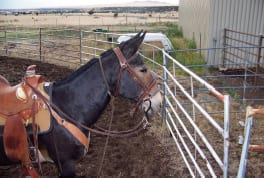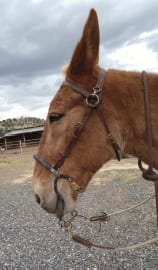Should I Be Using A Mechanical Hackamore?
A lot of clients email me with questions about hackamores and I do my best to respond quickly, to get them the information they need so they can get back in the saddle. A recent question came in about using a hackamore. Here is what the client had to say:
What kind of bridle or hackamore do you use on your donkeys? I got a new donkey a little over a year ago and she is very spirited and a quick learner, but she likes to fight her mechanical hackamore when she wants to go. I have tried a couple other bits and hackamores but she doesn’t listen to them at all. I would really appreciate the help.
What Is A Mechanical Hackamore
First, it’s important to understand what a hackamore is and why it’s used. A hackamore is a bridle without a bit. A mechanical hackamore is a bitless bridle with shanks.
The shanks on the mechanical hackamore provide leverage. Rather than pressure being applied in the mouth, the hackamore has a special type of noseband that communicates to pressure points on the nose and chin. When the reins are pulled, the crown of the bridle is pulled down behind the mule’s ears, the nose piece is pulled against the mule’s nose and the chin strap applies pressure against the chin in a similar fashion to the action of a curb bit.
The noseband can be just a rubber hose over a bicycle chain on the mule’s nose or it can be a bicycle chain with braided leather on the nose or it can be a flat nose piece that goes across the nose, and some people even use use straight chain, which is not very comfortable for the mule. Those are four different types of mechanical hackamores. The noseband, the nose piece itself has different designs to get different results.
The braided leather nose piece is the one you start out with because it gives you more communication value and is a little rougher so the mule will start responding, getting his nose on the vertical. As you progress, you’ll move to a rubber nose piece which is not as aggressive as the braided one. When the mule gets really easy and light and you barely have to pick up the reins, then you move to the flat nose piece. These are some of the different stages, in general, for what it would look like to have these different nosebands.
What You Need to Know About Using A Hackamore On Your Mule or Donkey
A hackamore should only be used if you can ride 80% using only your legs. Mules and donkeys care more about their nose than they do their mouth; their noses are VERY sensitive. In this regard, you could be using a hackamore that is not properly designed for the mule and donkey, so it isn’t communicating with the nose. It is also possible that you have it in the wrong place.
There are two things I’d like you to do for your donkey.
- Make sure the teeth are floated properly and done every year.
- Make sure the wolf teeth are pulled.
After you do those two things, try the hackamore again. If it still isn’t working, it could be in the wrong place. Here’s how you place the hackamore correctly. The hackamore should be placed two inches above the donkey’s nostrils, which is the beginning foundational position. As the mule progresses, you’re going to move the hackamore farther up the nose. Here’s a photo of correct hackamore placement on a donkey.




If you’ve fixed your mule’s or donkey’s teeth and the hackamore is placed properly, it might be that you need a mule and donkey hackamore. I use a mechanical hackamore on all my mules as a way to refresh a mule. This hackamore is top quality and features a rubber nose band and adjustable chin strap. Here’s a link to my mechanical hackamore. You shouldn’t have any more problems.
You can always call or email me if you have more questions about hackamores. I’m always happy to help mule and donkey owners get the most rewarding behavior from their animals.
Happy Trails!
[av_productgrid categories=’40’ columns=’3′ items=’1′ wc_prod_visible=” wc_prod_hidden=” wc_prod_featured=” offset=’4′ sort=’0′ paginate=’no’ av_uid=’av-216ras’ custom_class=”]
- Posted in: Articles, Everything
- Tagged: Articles, Everything


